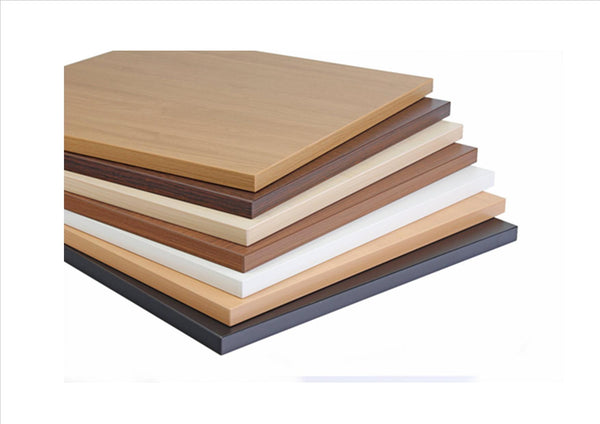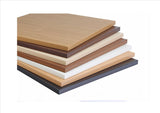Hospitality Table Tops - Melamine or Laminate?
PreviousNufurn
Indoor
Made to Order - All Sizes Catered For
No
Not Required
Australian Made - Approx. 2 Weeks
1
When it comes to selecting Hospitality Table Tops for your venue there are literally thousands of colours, effects and textures available to choose from.
Choosing the right look for your venue is hard enough however what can really be confusing is differences, which often aren't detailed, between the material used to make these table tops.
Hundreds of companies around the world manufacture Decorated Board Materials for companies like Nufurn to shape and finish into Hospitality Table Tops. Many of the countries that export these products into Australia do not have the same Health or Environmental standards as Australia regarding the appropriateness and safety of the materials used.
It is also really important to make the distinction between the boards used to make flat packed domestic or office furniture, which do not need to be rated for toxic emissions, be moisture resistant, be highly abrasion resistant or be as structurally rigid as hospitality table tops.
We hope this helps you to understand the key differences in the way most Hospitality Table Tops are described, by most sellers in the Australian marketplace.
Laminate - Definition:
‘Overlay (a flat surface, especially paper) with a layer of plastic or some other protective material’.
In Hospitality Furniture:
The terms Laminate and Melamine are often used interchangeably when describing Hospitality Table Tops. Both products are used extensively to produce commercial hospitality furniture however there are some important differences. It’s helpful to know that what you’re purchasing is fit for purpose and the best option for you.
We know the products as Melamine & Laminate however, from a specification and manufacturing point of view, the correct names are Low Pressure Laminate (Melamine) & High Pressure Laminate (Laminate).
99% of the time - Hospitality Table Tops will be a 'Melamine' product.
Basic Product Comparison:
Low Pressure Laminate or ‘LPL’ = Melamine
Also known as ‘Pre-Finished Board’, Melamine refers to the thin, single sheet of paper that is bonded with ‘Melamine Resin’ to a substrate board. For Commercial Hospitality Furniture we use Moisture Resistant Boards.
The ‘Low Pressure’ refers to the manufacturing process – Melamine is manufactured at 200-350kgs per-square-metre of pressure and at a temperature of 170°C-190°C.
Melamine is best suited to vertical, low impact applications – such as desk and table tops.
Melamine is the most cost effective option as we are able to purchase the ‘Pre-Finished Boards’ direct from the manufacturer (Polytec & Laminex) in a wide range of colours and finishes which require only basic finishing to cut to size. We then apply impact absorbing edge banding for table tops.

High Pressure Laminate or ‘HPL’ = Laminate
Producing a Laminate is a multi-step process. The ‘laminate’ product itself is made up of 6-8 layers of resin impregnated Kraft paper, a decorative paper (with pattern or colour) and a clear, protective, overlay. This produces a laminate sheet usually 0.7mm to 1mm thick.
The laminate sheet is then bonded to a suitable substrate. For Commercial Hospitality Furniture we use Moisture Resistant Boards.
The ‘High Pressure’ refers to the manufacturing process – Laminate is manufactured at 1,000kgs per-square-metre of pressure and at a temperature under 140°C.
Laminate is often used to produce shaped or architectural products where the builder or joiner will cut the laminate sheets to the appropriate shape and size before bonding the pieces to the substrate.
High Performance Laminate are generally over specified for hospitality applications, therefore are not the most cost efficient option.

Moisture Resistant Board Core:
Nufurn uses only products that are bonded to Moisture Resistant Particleboard Cores. This ensures our table tops (unlike most imported, domestic or office table tops) is suitable for use in even the wettest of hospitality venues.
Please note though that Melamine or Laminate Hospitality Table Tops are only intended for Indoor use and that moisture resistance does not mean waterproof.
Your Melamine or Laminate Hospitality Table Tops should not be submerged in water or left in the rain. If you'd like a product that withstand those environments, consider our range of Compact Laminate Table Tops (click here).
Emissions Ratings:
Our particleboard cores are either E0 or E1 (emissions rating) which renders them perfectly safe for indoor use, ensuring staff, guests and the environment are not exposed to harmful, toxic emissions from low quality bonding agents used in low quality table tops. Be aware that many other countries do not have these safety and environmental standards and that imported products may be putting you and your guests at risk.
Our Particleboards:
Polytec Melamine Particleboard Core:
16mm-33mm Moisture Resistant (MR), E1 Particleboard (PB) factory bonded with resin, impregnated paper (Kraft) on both sides. The hardened resin creates an outer layer providing an excellent surface for all applications.
Click for Polytec Melamine Table Top Care & Maintenance Guide
Laminex Vertiboard Particleboard Core:
13mm-33mm Moisture Resistant (MR), E0 particleboard, factory bonded with resin, impregnated paper (Kraft) on both sides. The hardened resin creates an outer layer providing an excellent surface for all applications. The superior performance of Laminex Vertiboard MR is due to the bonding of the wood particles with a specially blended moisture resistant resin system.
Click for Laminex Melamine Table Top Care & Maintenance Guide
In Summary:
Melamine is the best and most popular option for commercial hospitality furniture, particular table tops due to the ready availability of the pre-laid boards, the low cost of producing high volumes of those pre-laid boards as well as the low cost to convert those boards (often as large as 3600mm x 3600mm) into smaller table tops.
99% of the time, if a commercial furniture supplier refers to table tops or furniture as ‘Laminate’ what they mean, and will supply, is ‘Melamine’.
Assembly Considerations:
Melamine & Laminate Hospitality Table Tops should not require pre-drilling of holes as the particleboard core can be screwed directly into.
Method for attaching your Melamine & Laminate Hospitality Table Tops to your Nufurn Restaurant Table Bases:
1.
Ensure your table tops are on a soft surface - to prevent scratching the surface
2.
Sometimes the underside is not the same colour as the top-side. Make sure you are drilling into the underside!
3.
With the top-side facing down (underside facing up) position your table base in the centre of the underside.
4.
Check your screw is long enough and not too long! Place the table base fixing plate on the table top with at least one hole overhanging the edge of the table top. put a screw in the hole - it will drop through and you'll be able to see how far into the particleboard core your screw will go.
a) You want at least 10mm's depth of screw into the material.
b) You do not want to go within 5mm of the Top Side.
c) Even if Nufurn has supplied the screws - you must check them yourself. Nufurn is not responsible if you attach your own table tops. Even if we've supplied the screws.
5.
Position your table base correctly.
a) To be precise, measure the distance from all 4 corners and all 4 sides however a little off centre will not be noticeable or impact stability.
b) If the table base is a 4 way style - the feet should be pointing INTO the corners of the table top. The base will not be stable if the feet point into the middle of the edges.
c) If you are using a square base, table base - the corners of the base plate should be pointing into the corners of the table top.
d) Take extra time and care to line up the feet/corners so they are close to identical on all tables. It look AWFUL otherwise and can create a foot stubbing and trip hazard.
6.
Using a SCREW setting on your drill and a LOW SPEED insert your screws.
a) Nufurn will usually supply self tapping screws at the appropriate length for the table base and table top combination we supply to you.
b) If you are using your existing table bases - please be extra careful with screw length.
c) Most table bases have 8 screw holes. It is important to insert all 8 screws.
d) Insert the 4 outer corner screws first. This will help you position the base correctly.
e) Drill slowly so not to strip the holes you are creating. If you strip the holes, your screws may be loose or fall out.
f) Do not overtighten the screws or you risk stripping the threads/holes. Ensure the screw head is flush with the table base fixing plate however do not continue to drill.
Handling / Moving Tips
Always lift your tables by the STEM of the table base when turning the tables over, onto their feet or when picking them up completely off the floor.
It is suitable to drag table tops by pulling the edge or corner if you are moving them short distances however you should never pick up a table by holding the table top.
We can't stress this enough. Some of the table bases weigh 20+ kgs and could tear out screws particularly if you haven't used the right screw gauge, depth or number of screws.
The vast majority of calls we have fielded from clients over the past 25 years, about their table tops, is because they have failed to follow these simple assembly instructions TO THE LETTER.
How to order?
Submit a quote request online with a description of the type of seating arrangement and design you wish to have in your venue and we will take care of the rest. Alternatively you can give us a call on 1800 650 019 or email customer.service@nufurn.com.au and a Nufurn Furniture Specialist will guide you through the best solution for your venue.









